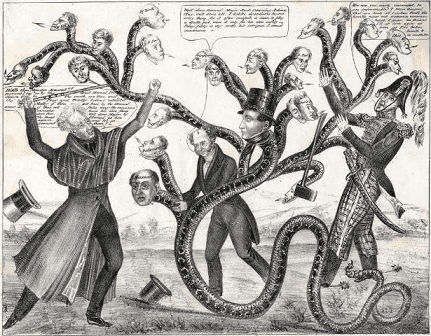 | ||
Tsarist autocracy (Russian: царское самодержавие, transcr. tsarskoye samoderzhaviye) refers to a form of autocracy (later absolute monarchy) specific to the Grand Duchy of Moscow, which later became Tsardom of Russia and the Russian Empire. In it, all power and wealth is controlled (and distributed) by the tsar. They had more power than constitutional monarchs, who are usually rested by law and counterbalanced by a legislative authority; they even had more authority on religious issues compared to Western monarchs. In Russia, it originated during the time of Ivan III (1440−1505), and was abolished after the Russian Revolution of 1917.
Contents
Alternative names
This system has also been described by the following terms: imperial autocracy, Russian autocracy, Muscovite autocracy, tsarist absolutism, imperial absolutism, Russian absolutism, Muscovite absolutism, Muscovite despotism, Russian despotism, tsarist despotism or imperial despotism.
History
The Tatar Yoke and the Mongol ideas and administrative system are credited with bringing the culture exhibiting some characteristics of an oriental despotism to Russia. Absolutism in Russia gradually developed during the 17th century and 18th centuries, replacing the despotism of the Grand Duchy of Moscow. Ivan III built upon Byzantine traditions and laid foundations for the tsarist autocracy, a system that with some variations would govern Russia for centuries.
After a period of disorder known as a Time of Troubles, the first monarch of the Romanov dynasty, Michael of Russia, was elected to the throne by a Zemsky Sobor (or "assembly of the land"). During Michael's reign, when the Romanov dynasty was still weak, such assemblies were summoned annually. However, the Romanov dynasty consolidated absolute power on Russia during the reign of Peter the Great, who reduced the power of the nobility and strengthened the central power of the tsar, establishing a bureaucratic civil service based on the Table of Ranks but theoretically open to all classes of the society, in place of the nobility-only mestnichestvo which Feodor III had abolished in 1682. Peter I also strengthened the state's control over the church (the Orthodox Church). Peter's reform caused a series of palace coups seeking to restore the power of the nobility. To end them, Catherine the Great, whose reign is often regarded as the high point of absolutism in Russia, in 1785 issued the Charter to the Nobility, legally affirming the rights and privileges they had acquired in preceding years, and the Charter of the Towns, establishing municipal self-government. This placated the powerful members of society; however, in fact, the real power rested with the state's bureaucracy. This was built on by later Tsars. Alexander I established the State council as advisory legislative body. Although Alexander II established a system of elected local self-government (Zemstvo) and an independent judicial system, Russia did not have a national-level representative assembly (Duma) or a constitution until the 1905 Revolution. The system was abolished after the Russian Revolution of 1917.
Features
The person of the tsar himself, a sovereign with absolute authority, stood at the center of the tsarist autocracy. The rights of state power in their entire extent belonged to the tsar. The autocrat further entrusted power to persons and institutions, acting in his name, by his orders, and within the limits laid down for them by law. The purpose of the system was to supposedly benefit the entire country of Russia. A metaphor existed likening the tsar to a father, and all of the subjects of the Empire, to his children; this metaphor even appeared in Orthodox primers. This metaphor is present in the common Russian expression "царь-батюшка", literally "tsar-dear father".
Furthermore, unlike in western monarchies subject (in religious matters) to the Pope, the Russian Empire combined monarchy with the supreme authority on religious issues (see Church reform of Peter I and caesaropapism for details).
Another key feature related to patrimonialism. In Russia the tsar owned a much higher proportion of the state (lands, enterprises, etc.) than did Western monarchs.
The tsarist autocracy had many supporters within Russia. Major Russian advocates and theorists of the autocracy included writer Fyodor Dostoyevsky, Mikhail Katkov, Konstantin Aksakov, Nikolay Karamzin, Konstantin Pobedonostsev and Pyotr Semyonov. They all argued that a strong and prosperous Russia needed a strong tsar, and that philosophies of republicanism and liberal democracy did not fit Russia.
Influences
Some historians see the traditions of tsarist autocracy as partially responsible for laying groundworks for the totalitarianism in the Soviet Union. They see the traditions of autocracy and patrimonialism as dominating Russia's political culture for centuries; for example, Stephen White wrote that Russian political culture is "rooted in the historical experience of centuries of absolutism." Those views had been challenged by other historians, for example, Nicolai N. Petro and Martin Malia (as cited by Hoffmann).
